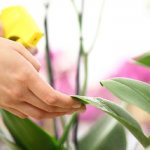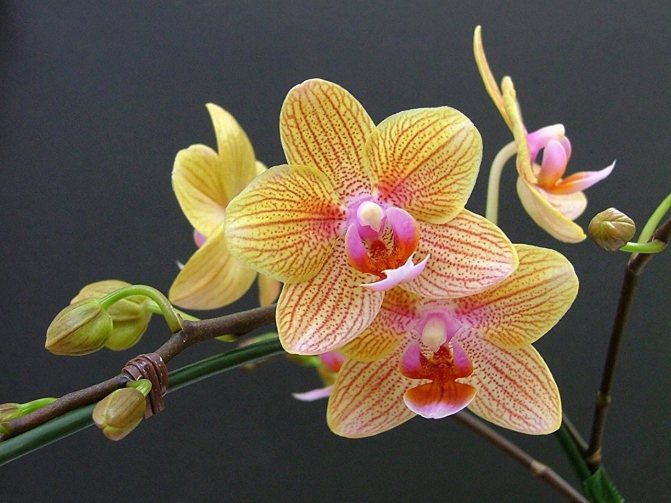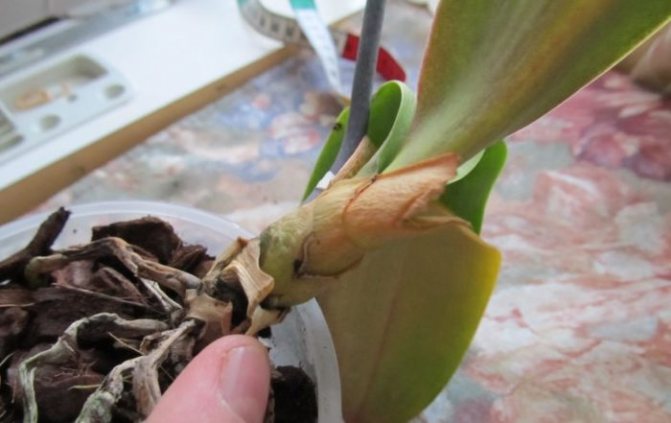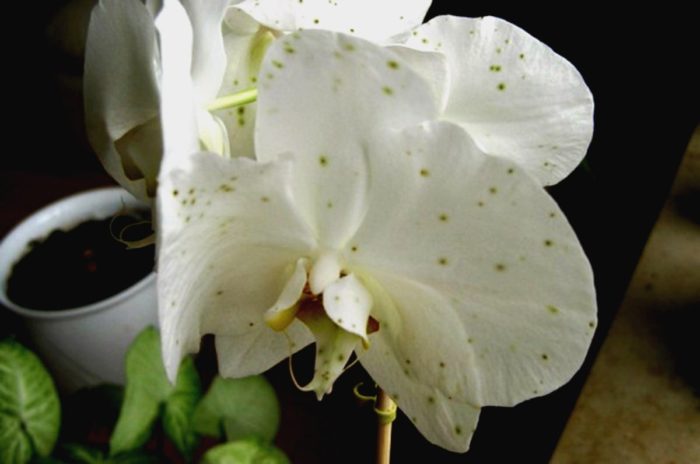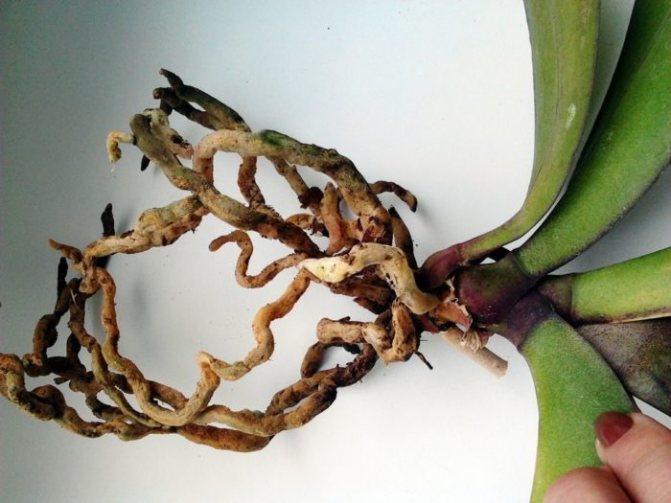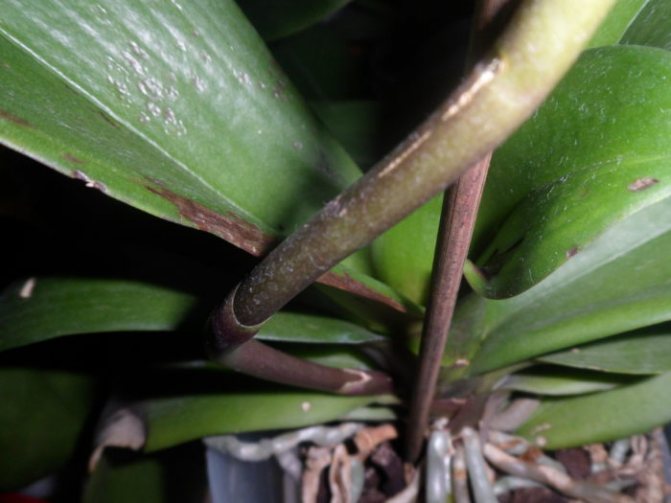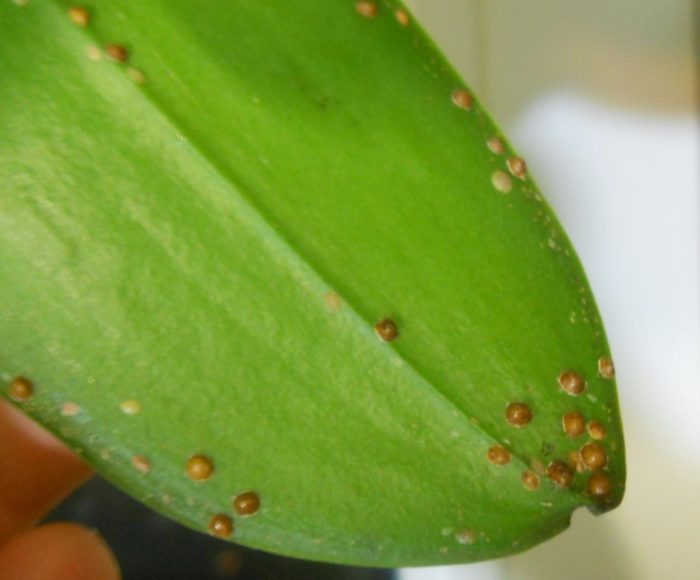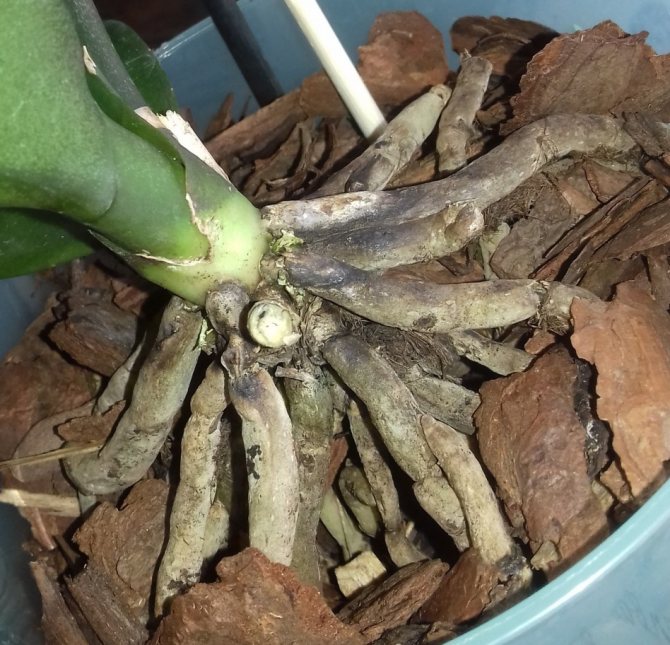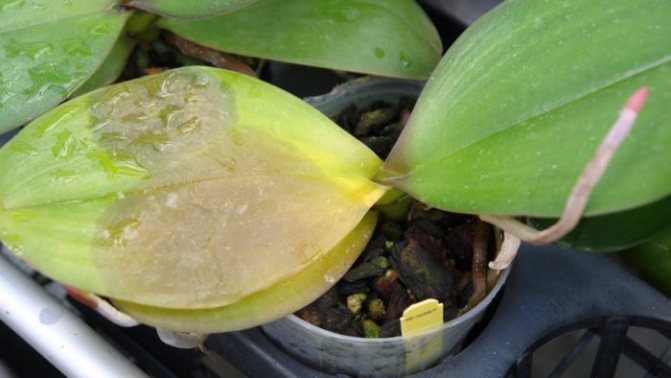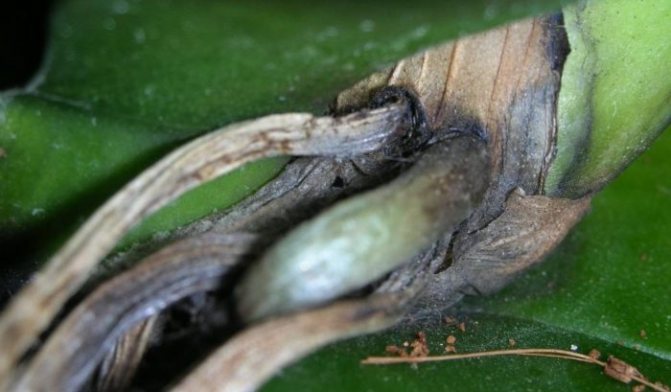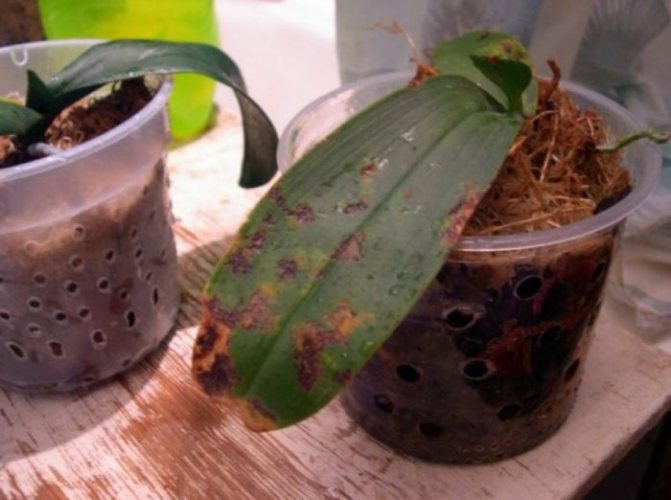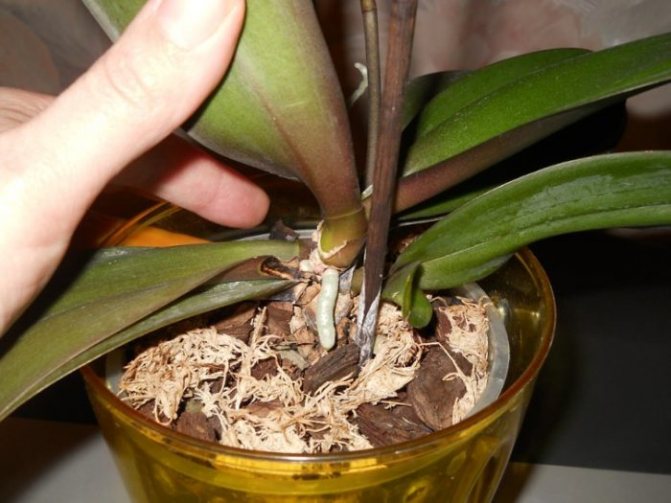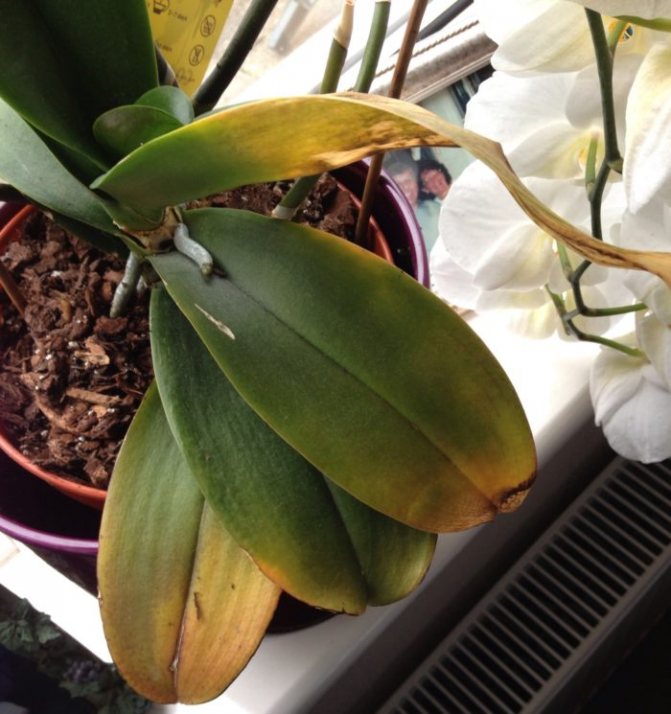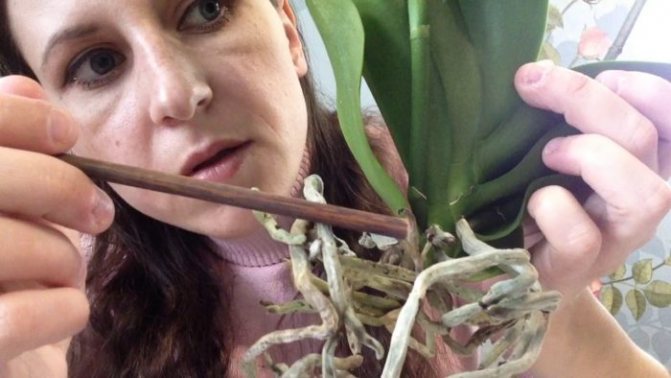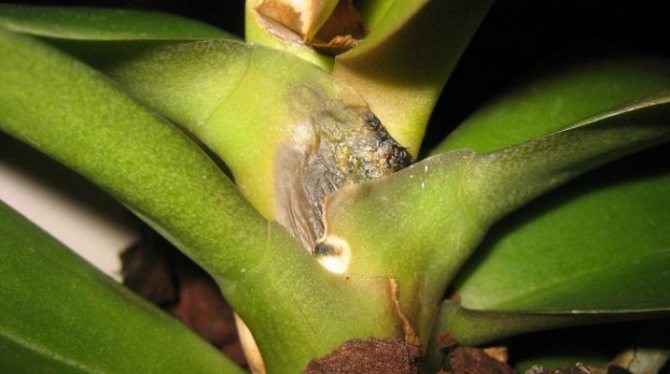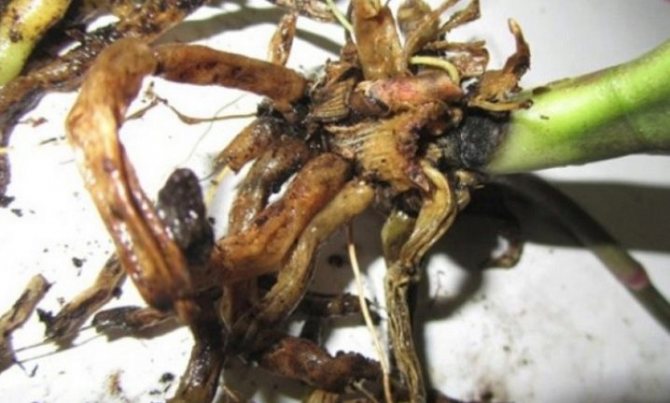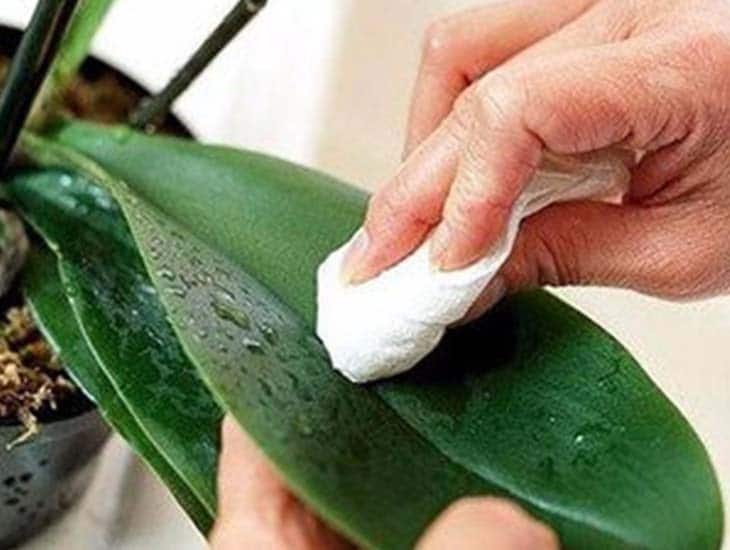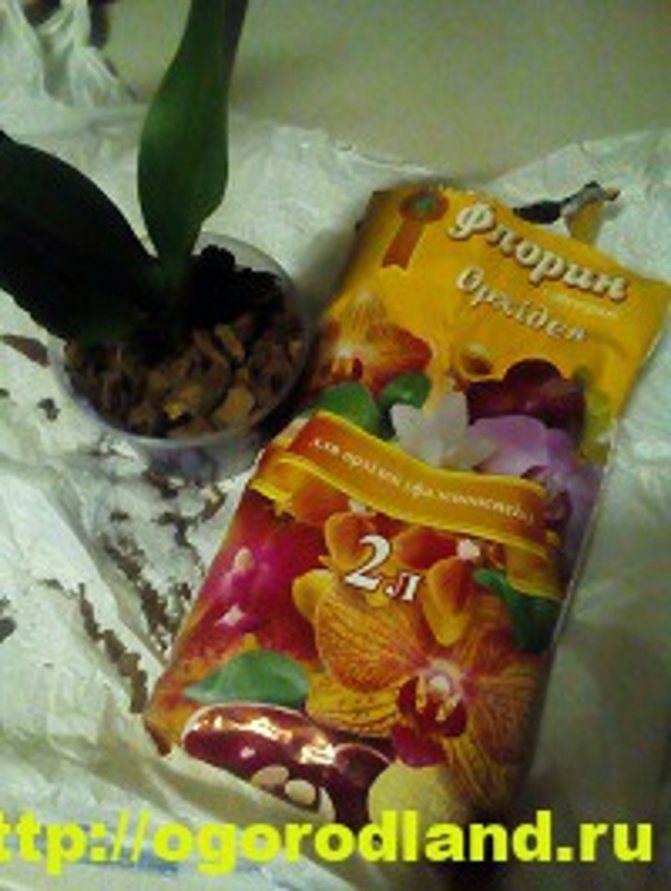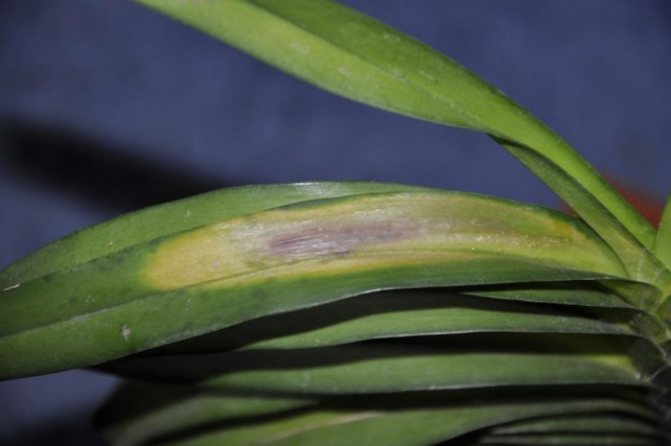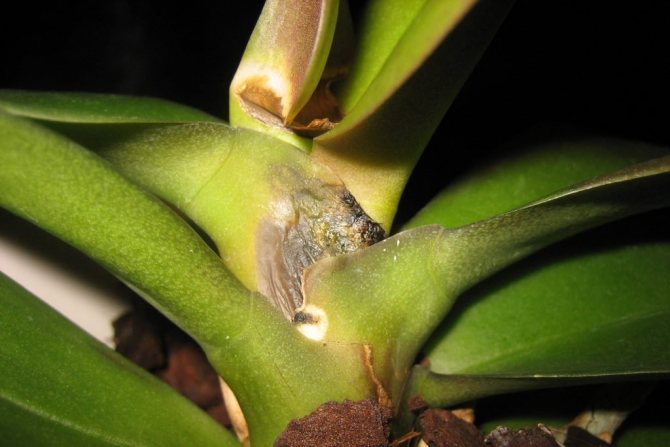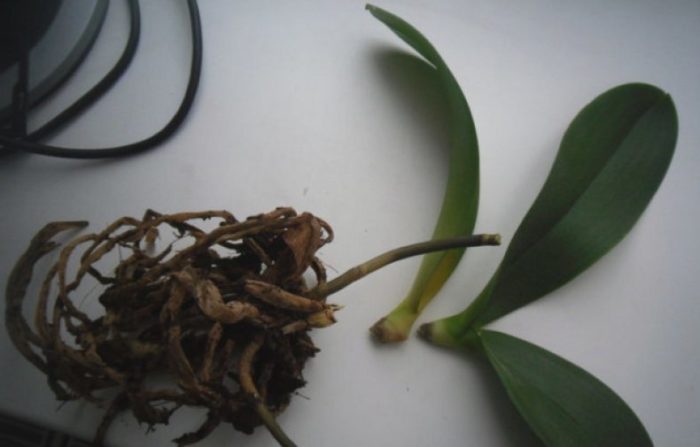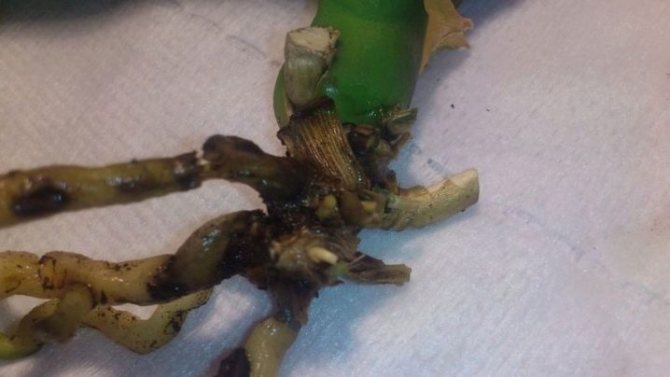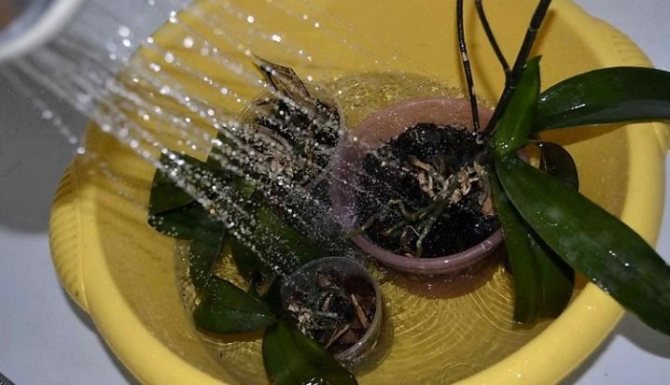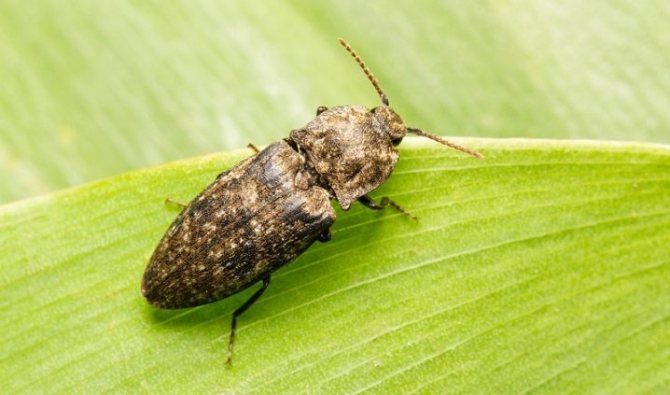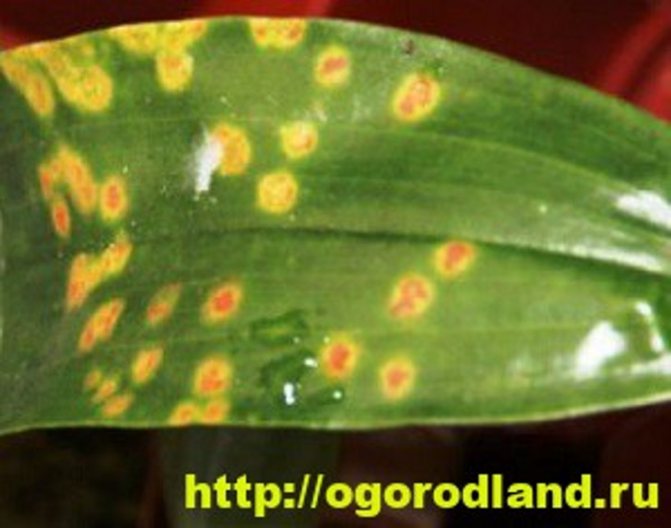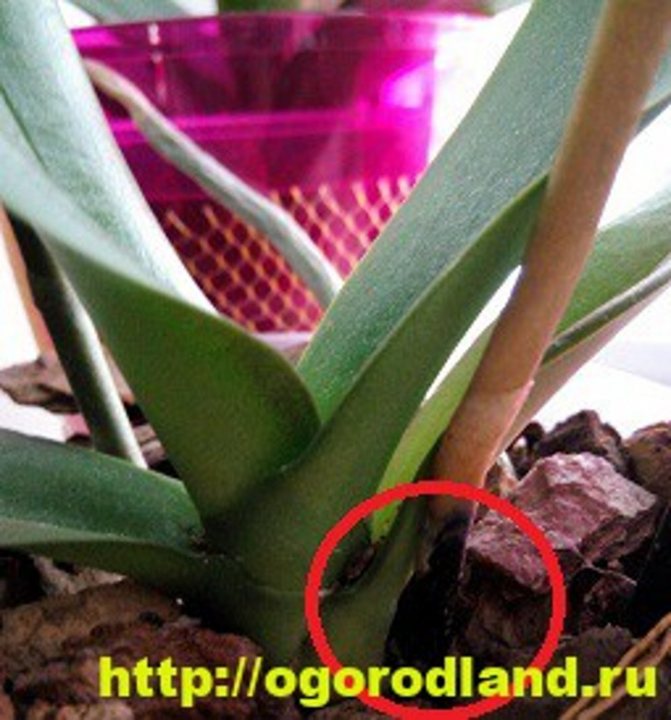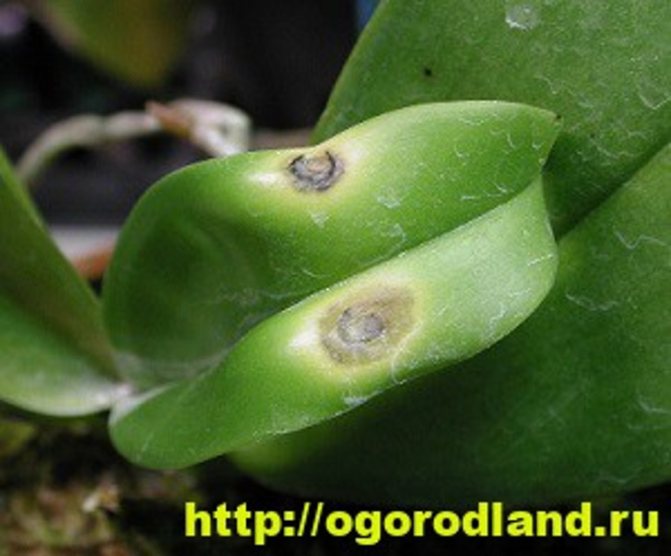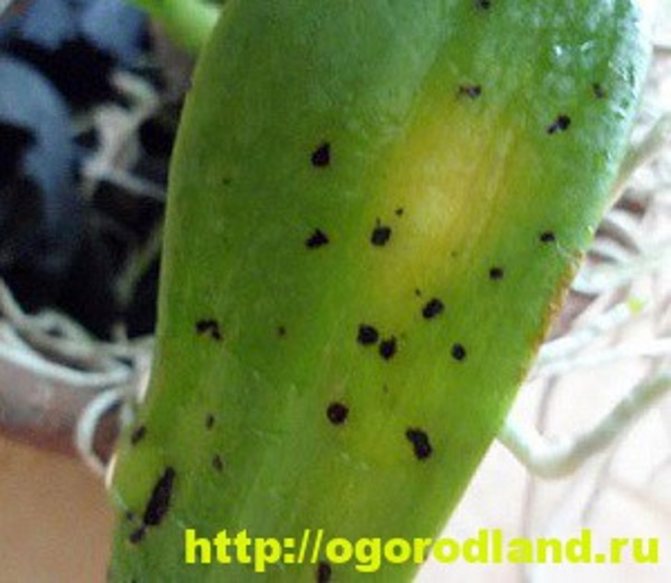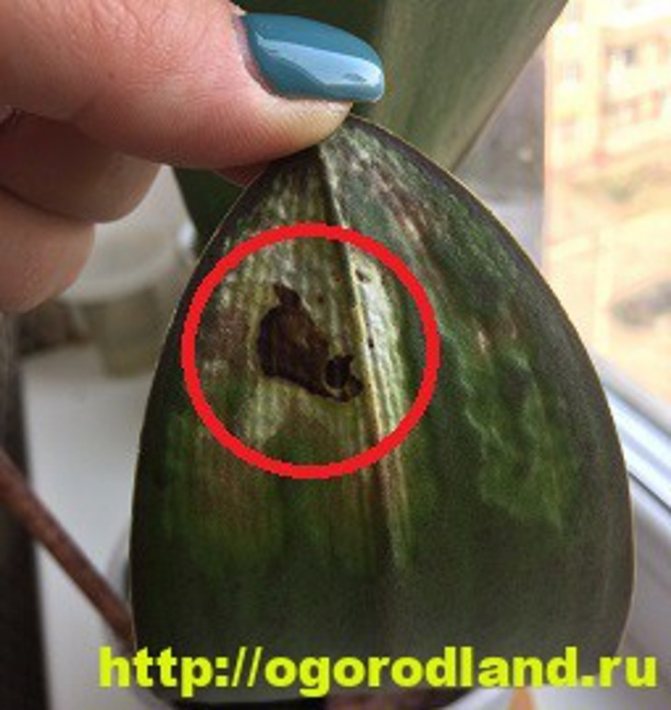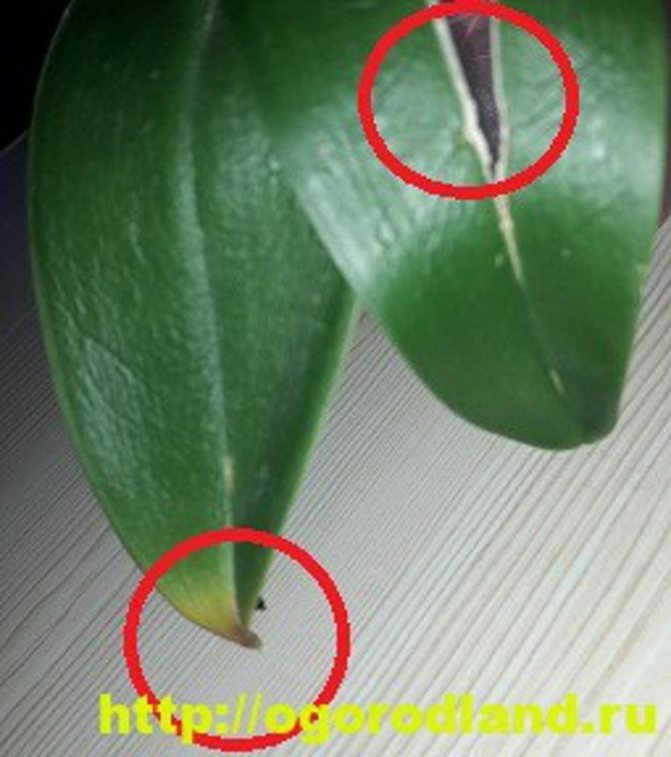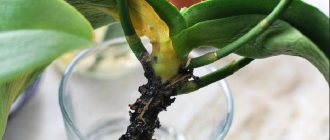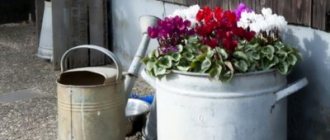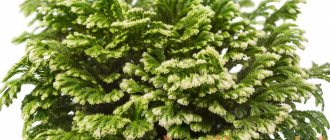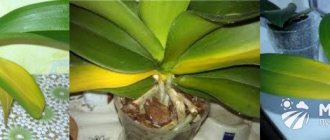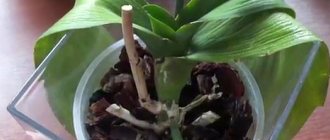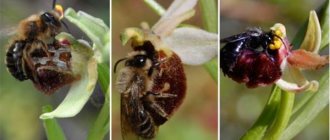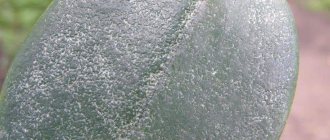Phalaenopsis orchid is a precious decoration of a home flower garden. However, growing these beautiful plants is complicated by the fact that they often suffer from rot - diseases that can be caused by bacteria or fungi. Check your green pets more often in order to take timely measures to save them and, of course, follow the rules for keeping them.
There are several types of rot that the phalaenopsis orchid suffers from:
- black rot;
- brown rot;
- root rot;
- fusarium rot;
- gray rot.
How to prevent rotting
It is recommended to grow orchids in transparent containers. Experts associate this with the peculiarities of the existence of a plant in nature. Phalaenopsis roots are visible in glass or plastic transparent containers. They should be light green when healthy and moist. If the roots become pale green or white, and the leaves wither, then phalaenopsis needs moderate and regular watering. Contrary to popular belief, orchids are quite tenacious, so that minor flaws in the care are unlikely to cause rapid rotting of the root system.
As a rule, orchid diseases are associated with improperly selected soil or a pot that is too loose for transplanting. There should be no dense particles of soil in the soil, because this can cause stagnation of water, leading to the death of roots and preventing the flow of oxygen. It is best to use a substrate for transplanting phalaenopsis, which consists of sphagnum moss and dry pine bark. You can prepare such a composition yourself.
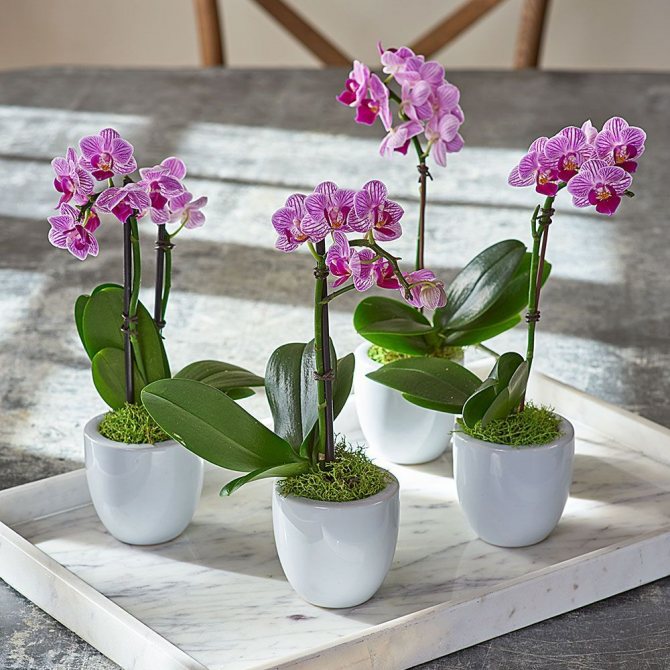
Instructions on what to do depending on the affected part of the plant
Orchids are quite susceptible to all kinds of diseases. Therefore, it is important to immediately recognize the signs in order to understand what to do if the growth point, core or neck at the base of the leaf decays. Unfortunately, members of the Orchid family are often affected by rot. This is directly related to the wrong conditions of detention.
Growth point
The first step is to determine the cause of the disease. If mechanical damage, overheating, or hypothermia is to blame, then there is no need to isolate the plant. If there is a peduncle with buds, it should be cut off, leaving a part of the stem with 2-3 buds.
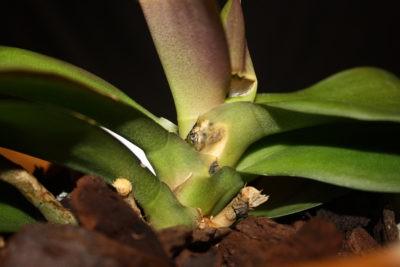

What to do if the growth point has rotted? Treatment will be as follows:
- Remove all damaged tissue so that no dark spots remain anywhere.
- Disinfect the sections.
- For infectious diseases in orchids or as a precaution against infection, topical fungicides should be used.
- Examine the diseased flower regularly to see if the decay process has resumed.
- The buds on the peduncle can be treated with cytokinin hormonal paste to stimulate the appearance of children.
Core
In order to prevent rot from spreading inside the flower, you should take prompt measures:
- Remove all rotten areas down to living tissue.
- Removal of the entire core is possible.
- After each cut, treat the instrument with alcohol.
- Burn the wounds with iodine or brilliant green, ground cinnamon, activated carbon.
- Monitor the condition of the plant.
- If after a while you notice the appearance of new rot, then repeat the stripping procedure.
Neck
Rot symptoms: the leaves turn yellow, falling off the neck of the stem. It is difficult to see the disease visually, because rotting occurs in the neck itself.
The reasons:
- frequent watering;
- long nailing of roots in wet soil;
- low ambient temperature.
Treatment:
- Prepare a sharp blade and disinfect.
- We cut off the entire rotten part of the neck to living tissue.
- We clean up the slices with a blade.
- Treat the soil and the plant with a 0.2% solution of Fundazol or Topsin. We pour the preparation directly into the wound of the plant.
- The procedure should be carried out at least three times with an interval of 2 weeks.
- We insert the pot in its original place, expect the appearance of a side baby.
Features of the structure of the root system
If an orchid has rotten roots, what to do to revive the plant? In order to avoid future mistakes, it is necessary to determine what exactly caused the decay. Phalaenopsis has a special structure of the root system. The plant does not have hairs on the roots, through which moisture usually flows. The upper part of the root consists of hollow cells, into which liquid enters through capillaries. Moisture can be "pumped" from one layer of cells to another. Due to this, the water first moves to the center of the system, and only then upward. In order for the water to pass freely between the layers, certain conditions are necessary, for example, bright light.
Decay problems occur, as a rule, in winter. During this period, in the middle lane, the deficit of sunlight is felt especially acutely. In their natural environment, orchids live in the tropics, where there is no need to face a lack of sun. But when there is not enough light, all the moisture remains in the upper layers, which causes the leaves to turn yellow. In loose soil, a small amount of water will naturally evaporate, but some of it can cause root rot.
Powdery mildew on an orchid
Powdery mildew not uncommon in the practice of breeding orchids. This disease is very often faced by those who are just starting to grow orchids and still do not know everything about caring for them.
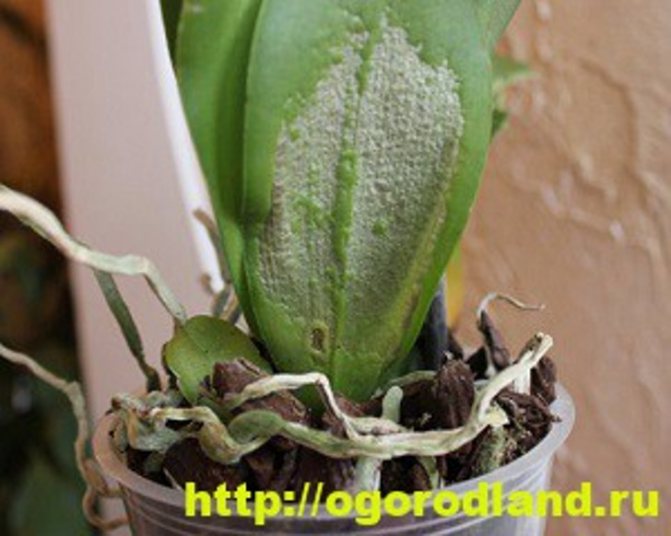

Powdery mildew on an orchid
Such a disease arises due to the fact that the plants were susceptible to the greenhouse effect, in other words, there was a lot of moisture and very hot. Often this happens when the orchid is well watered and it is standing near a heat source. As a result, there was a lot of fumes and hence the plant was exposed to powdery mildew.
It is simply not realistic not to notice it. Powdery mildew appears as a white bloom on orchid foliage and flowers. It is necessary to start treatment immediately, as soon as you see its manifestation, otherwise it will simply not be realistic to save the plant.
The first thing to do is remove all plaque. If, as a result of the occurrence of powdery mildew, rotting has not yet occurred, then rubbing off will be enough, and if rot has already appeared under the bloom, then it is necessary to cut off the damaged areas with a sharp, sterile object. Treat the entire plant with Topsin-M.
After the events, be sure to normalize the conditions for keeping your orchid.
Why does an orchid have roots rotting
If the roots of an orchid have rotted, this may be caused by:
- compaction of the soil in which phalaenopsis grows;
- burns to parts of the plant;
- aggressive feeding;
- mechanical damage to the root system, for example, when transplanting a plant;
- attack by pests and diseases.
Fungal diseases, which are a common cause of root rot, are especially dangerous for orchids.
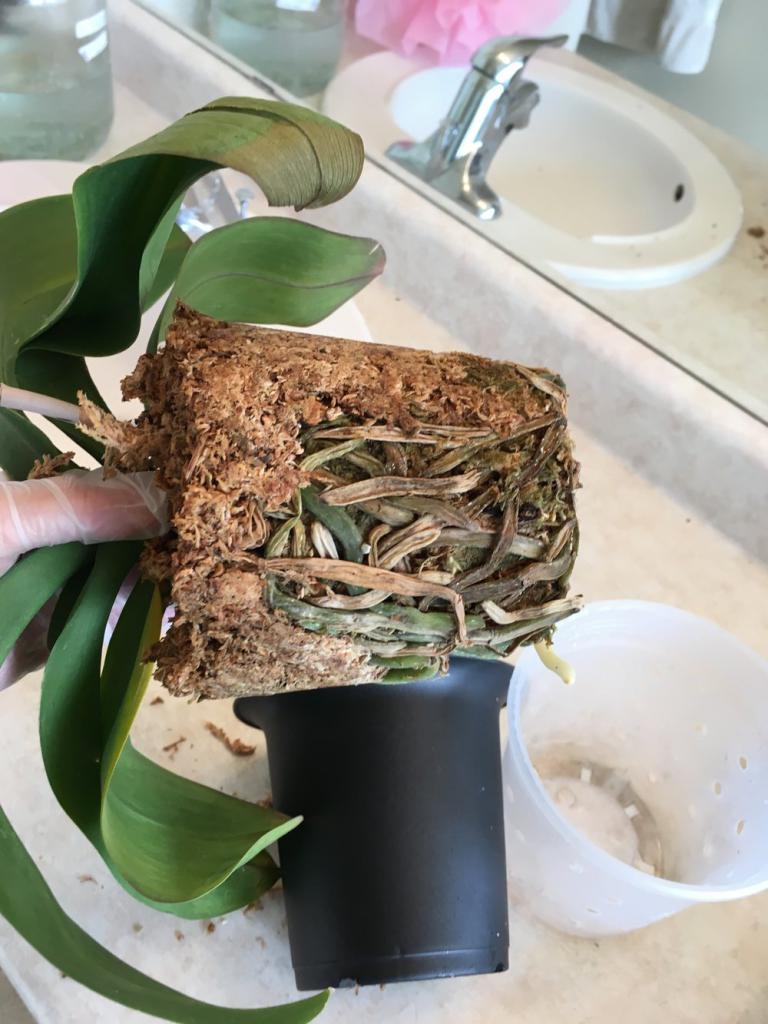

Phalaenopsis orchid root rot
If the leaves of the phalaenopsis turn brown and the roots soften, most likely plant amazed root rot orchids. The best conditions for the development of this disease are high temperatures and humidity in the room.
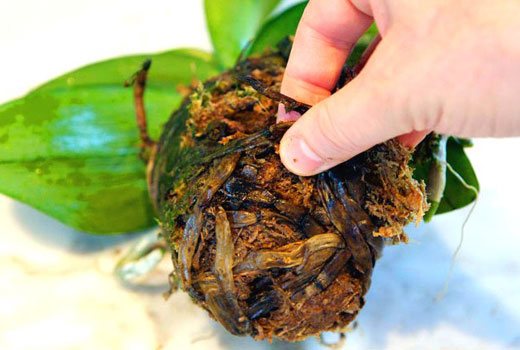

If the disease is neglected, the plant has little chance of survival.
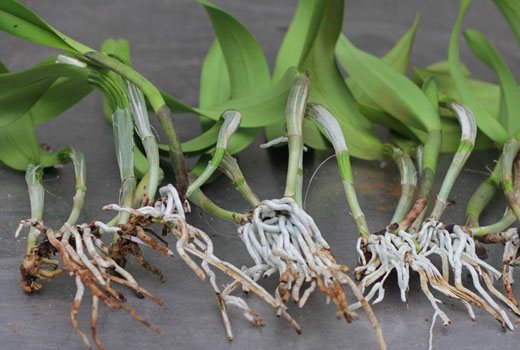

If the roots of the plant are only affected by rot, the orchid can be saved.
Compaction of soil in a pot
The optimal substrate for growing phalaenopsis is a mixture of moss and dry pine bark. Plants that are grown in ordinary soil are more likely to get sick and die faster. This is also due to the structural features of the root system. Even a substrate that is suitable in composition needs to be replaced from time to time with a new one. The soil loses its structure, becomes strongly compacted and can crumble into small particles. All this negatively affects the leaves and root system of the plant. If the roots of an orchid are rotten, what to do? Of course, saving phalaenopsis only by replacing the soil will no longer work, but in order to avoid such a situation, the substrate must be changed. It must not be allowed to seal.
Definition and external signs of trunk decay
Rot is a general definition of diseases caused by phytopathogenic fungi and bacteria. In the process of development, decay leads to damage to leaf blades, stems, roots, at a more advanced stage - to complete decay, drying out and quick death of decorative flowers.
Read more about why orchid leaves rot and what to do about it, read here.
External symptoms: small dark spots appear on the stem or at the base of the exotic, which grow over time. This phenomenon entails yellowing or darkening of the leaves at the base, which fall off en masse.
The general condition of orchids is characterized by:
- weakness;
- loss of turgor;
- decorative qualities deteriorate;
- the duration of flowering decreases;
- photosynthesis processes are often inhibited;
- growth stops.
Burn with fertilizers and dressings
Phalaenopsis is very sensitive to various feeding, so you need to be extremely careful in this matter. Potassium and phosphorus salts can especially negatively affect the condition of the plant. When using concentrated chemicals, the roots can get burned, after which they can no longer fully perform all their functions. What to do if an orchid has rotted roots due to chemical burn? It is necessary to immediately stop fertilizing and transplant the plant into fresh soil. When transplanting, the decayed areas of the root system are removed. If the lesion is minor, the plant will not need additional treatment.
The appearance of spots on orchid flowers
Spots on orchid flowers rarely appear due to a disease, the main reason for their appearance is mechanical damage. They usually dry out and the edges of these spots are always uneven.
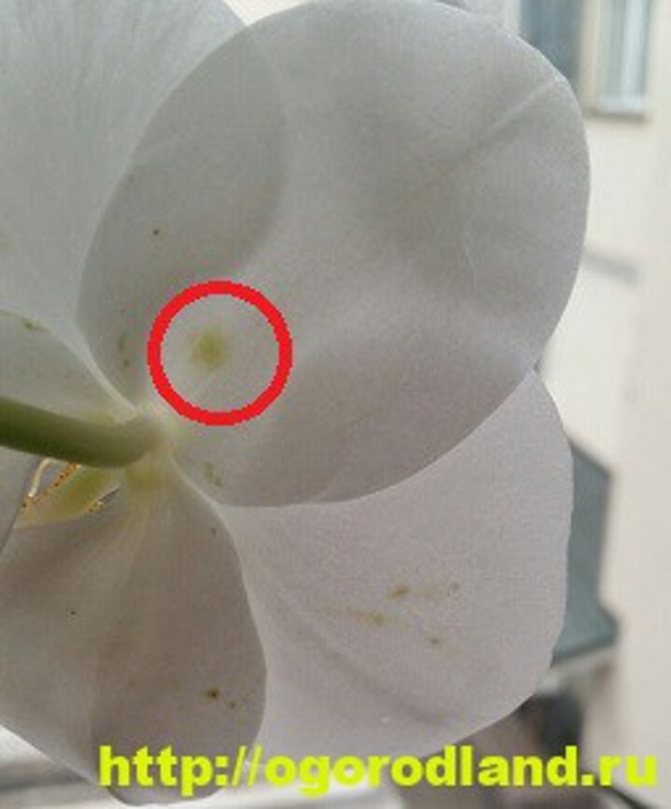

Orchid petals
They can appear even during transportation, if condensation has formed inside the package and the flowers were in a very high humidity.
Such spots also appear due to the fact that the flower was in the sun and at the same time there were drops of water on the flowers. In this case, the drop works like a water lens and the flower gets burned, which you see on the flower in the form of spots.
Quite rarely, but still it is possible, this is the defeat of the plant by the fungus. In this case, the spots appear very quickly. Within just one day, all flowers can become stained. Further, the whole plant will be affected by the fungus, the stems and foliage will become watery and mold will not slow down on them. In this case, it is urgently necessary to treat the entire plant with an antifungal agent, which can be purchased at any specialized store. Also, such a plant must be placed separately from the rest, otherwise all plants standing nearby, especially orchids, will be infected.
Mechanical damage
As the phalaenopsis grows, the plant needs to be transplanted. It is easy to damage the root system during transplantation.Even an insignificant cut will be enough for some part of the root to stop fully performing its functions. The root can start to rot, and then the rot will spread throughout the system, leading to the death of the plant. How to reanimate an orchid if the roots have rotted? In case of mechanical damage (if it is detected in time), it is usually sufficient to cut off the bad areas and disinfect the sections.
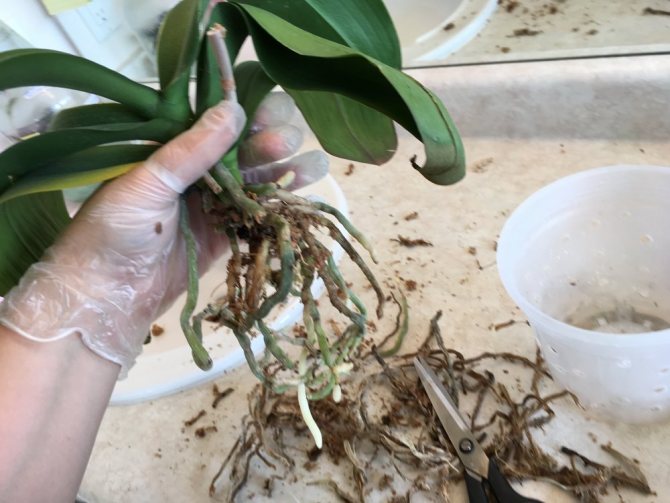

Why is there a problem?
The main factors that can lead to decay processes include the following:
- excessive watering;
- low room temperature;
- high humidity in the room;
- incorrect selection of top dressing;
- insufficient amount of light;
- unsuitable soil for growth;
- plant damage by fungal diseases.
Important! The cause of the putrefactive process can be mechanical damage to the leaves and trunk. Even a seemingly insignificant jam can cause rotting.
Fungi and bacteria
Most often, an orchid is affected by wet, gray and brown rot. Fusarium is often diagnosed in a flower. All these diseases manifest themselves as spots, which begin to grow rapidly from diseased areas to healthy ones.
Incorrect fertilization
When using complex mineral bases, the plant receives too much nitrogen. The substance suppresses the immunity of the flower, allowing diseases to infect peduncles and leaves.
Large amount of moisture
Frequent watering leads to the formation of fungus. The orchid should be watered only after the soil is completely dry, while the water should be settled and not cold.
Solid ground
An orchid cannot grow in dense soilwhere she lacks air. At the same time, water is constantly retained in such soil, which cannot drain into the sump.
Improper lighting and temperature
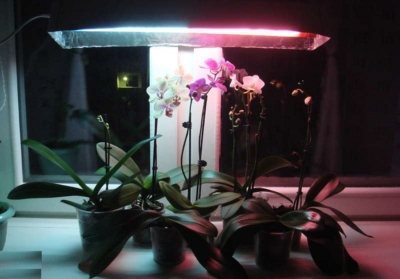

Insufficient light leads to rapid mold growth. The same process is facilitated by a violation of the temperature regime.
The orchid should stand on a windowsill in a room with a temperature of 18-24 degrees. In winter and in cloudy weather, the flower should be additionally illuminated with a phytolamp.
Rotting leaves can cause the death of the entire flower. In addition, the disease can quickly spread to other plants, especially those as delicate as the orchid. Because of this, all affected flowers should be quarantined.
Pest attack
How to reanimate an orchid if the roots have rotted and the leaves have fallen off? If the plant is in serious condition, then, most likely, it will not be possible to save it. But you definitely need to know the reasons for the death of phalaenopsis in order to prevent such mistakes in caring for other orchids. Perhaps the reason is the attack of click beetles. Such pests lay larvae that eat up the root processes. Rot occurs, which over time can spread to the entire plant.
As a result of the attack of click beetles, the orchid ceases to receive the required amount of moisture, which is why the leaves turn yellow and wither. How to save an orchid if the roots are rotten from pests? First, you need to thoroughly rinse the root system of the plant in warm clean water, and then change the soil to a new one and transplant it into the plant. The pot should be disinfected or a new one should be taken.
Phalaenopsis should not be watered for ten days after transplanting. It is necessary to wait this period to make sure that there is no pest left in the substrate or roots. The fact is that the larvae cannot stand drought. Infection may reappear if watering is started immediately. During this period, you should also abandon top dressing and the use of any chemicals, because a weakened root system can get burned.
Watering in a new place - strictly after a week
During transplantation, the roots of the plant are often washed, and also placed in a manganese solution and in a vitamin solution. These procedures keep the roots moist enough.Therefore, immediately after transplanting, additional watering of the flower is not required, otherwise it can lead to decay of the root system.
The first watering is recommended after the orchid adapts to a new place, this will happen in a week.
It is important to know that traditional watering is not suitable for these flowers - pouring water into a pot. The most suitable method is to immerse the pot in a container of water at a temperature of about thirty degrees. Growth extracts and suitable fertilizers can be added to the water. In this position, the flower must be left for twenty to thirty minutes, after which the pot is removed and the excess liquid is allowed to drain. The most suitable time for watering is the first half of the day.
Under natural conditions, this plant receives additional moisture through aerial roots from the environment during dew or fog. Therefore, air humidity of about fifty to sixty percent is favorable for it. In this case, you can moisten the leaves and aerial roots by spraying water from a spray bottle.
Thus, in order for the orchid to delight you with its healthy appearance for a long time, three simple rules must be observed when transplanting: choose the right soil, correctly cut off rotten roots and water for the first time a week after the procedure. Due to the observance of these rules, the roots of the flower can be protected from decay.
How to understand that the roots are rotting
How to reanimate an orchid, if the roots have rotted, at home? It will be possible to save the plant only if you notice in time that the roots are not in order. This can be determined by the following signs: the aerial part of the plant begins to stagger, traces of sporulation or green algae appear on the walls of the container, the leaves have lost their elasticity (they do not return to normal after watering), the aerial roots have darkened, dried or softened.
If at least one of these symptoms appears, the condition of the roots should be checked. To do this, the plant should be pulled out of the ground. It is necessary to determine how many live roots are left, and the rest must be removed immediately. You can start saving the plant only after this stage.
Signs of defeat
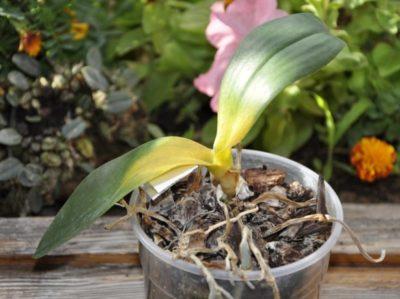

The presence of rot on orchids is determined based on the presence of the following symptoms:
- leaves lose their elasticity, bright color, tone;
- a brown tint appears at the base of the leaf;
- rapid dying off of green mass;
- the appearance of dark spots on the neck or trunk;
- brown spots are observed on the inflorescences;
- greenish traces of sporulation are visible on the walls of the flowerpot;
- loose, unstable top of the plant.
Growing new roots
If the roots of an orchid have rotted, how to save the plant? The method of resuscitation of phalaenopsis depends on how damaged the root system of the plant is. When the leaves become lethargic, the children stop growing, and watering does not work, you need to pull the plant out of the pot and inspect the lower part. Living roots are firm and firm to the touch. Due to the lack of light, they may turn brown, but this does not mean disease. Rotten roots become empty, sprawl in the hands, when pressed, water flows out of them. Such a plant can no longer be saved. It is necessary to cut off the areas affected by necrosis.
If all the roots have rotted, you can try to grow new ones. This method involves the use of a quality substrate with good structure and sufficient density. During the recovery period, you should try to water the plant as little as possible. This should only be done if the soil is dry. Otherwise, young roots may start to rot again. Watering is desirable in the morning with filtered water.
First, the cut sites must be disinfected. For this, activated carbon powder is used, and some gardeners use cinnamon. It is not recommended to use preparations containing alcohol.Such chemicals will only make it worse, because the weakened plant will be even more burned and dried out. This will make it much more difficult for healthy roots to grow.
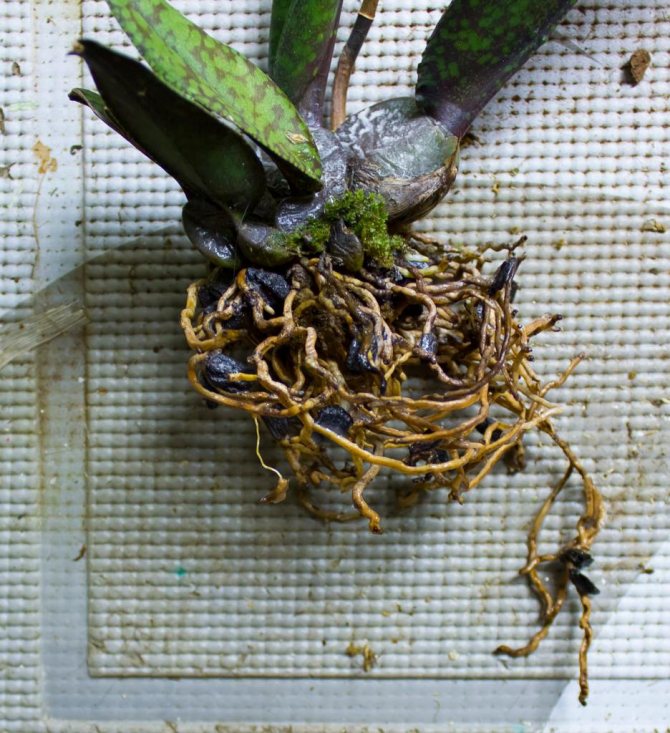

Then the orchid must be air-dried for three hours. The plant needs to be treated with "Zircon" or "Epin". The solution is diluted in clean water (one drop per liter of water). The remains of the roots are placed in the liquid for one to two hours, but the water should not touch the leaves. It is important to remember that it will be possible to successfully revive the plant only if the orchid receives enough light. In winter, for example, you need to illuminate with a phytolamp. It is also necessary to treat the leaves with succinic acid. This will help the plant recuperate faster.
Black and brown rot of orchids
This disease of phalaenopsis orchids (and not only) first appears on the leaves of the plant with watery brown or black spots. They quickly darken, spread out, capturing an ever larger area of leaves. The affected areas become soft, and fluid oozes from them when pressed. Usually rot disease orchids begins on young leaves, quickly descending down the plant - to pseudobulbs and roots. The process is accelerated at low temperatures of maintenance and too abundant watering.
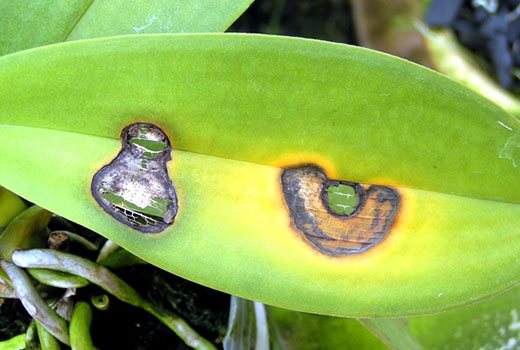

Black spots on the leaves of phalaenopsis are a signal of a formidable disease of the plant.
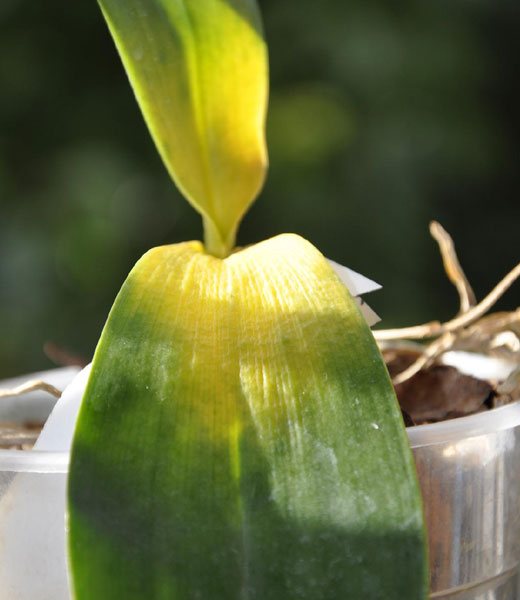

Black rot of the phalaenopsis orchid neck leads to the death of plant tissues.
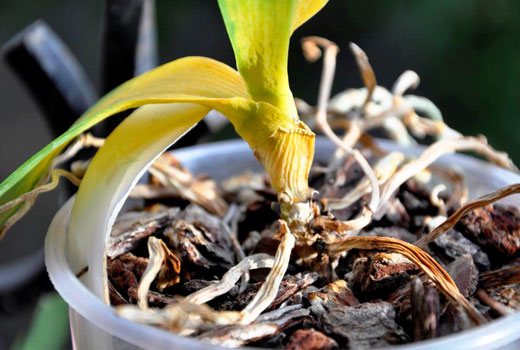

The plant died from black rot of the neck
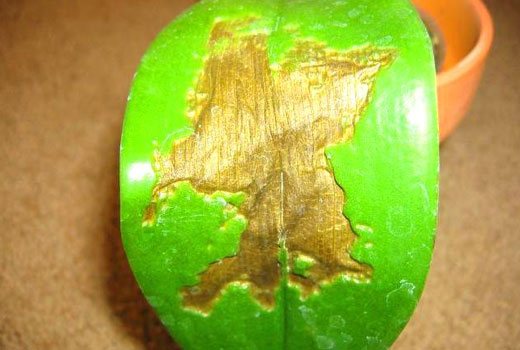

Brown rot spots on the orchid leaf.
Lighting and care in the greenhouse
The damaged plant must be provided with abundant and diffused lighting. Suitable air temperatures range from + 22… + 25 ° C. Low temperatures will not help new roots grow, but will only provoke mold. Too high a temperature will cause the orchid to actively evaporate moisture rather than absorb it. In this case, root growth will be impossible or significantly slowed down.
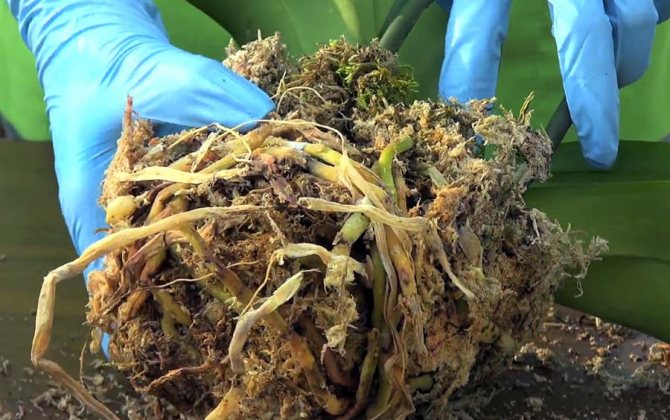

The greenhouse needs to be aired twice a day. This will speed up the formation of new roots. It is advisable to ventilate the greenhouse in the evening or at night. In winter, 20 minutes is enough for airing, and in summer you can leave the greenhouse open until early morning. This will only benefit the immature plant, which is recovering from improper care, pest attacks or chemical burns with fertilizers.
In places of contact with moss, you need to periodically inspect the root system of the plant and leaves. If dark areas filled with water are noticed, the phalaenopsis must be pulled out of the greenhouse and dried well, and then laid on the other side.
Prevention
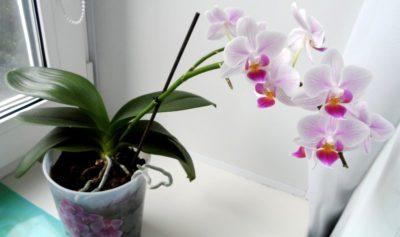

For the first time after amputation, be sure to adhere to the following recommendations:
- Maintaining a comfortable temperature in summer: + 22-25 ° C, in winter + 16-18 ° C. The difference in temperature differences should not exceed 5 ° C. At temperatures above + 25 ° C and high humidity, fungal infections develop, and at temperatures below + 15 ° C - bacterial.
- Humidity in the range of 50-60%.
- In the first week, do not water, and then once every 7-10 days, in between, the soil should dry out completely.
- It is imperative to remove stagnant water in the leaf axils after watering.
- Exclude the use of mineral preparations.
- Lighting is required diffused, not bright.
- Ventilate the room regularly, but the cold air should not get on the orchid.
It is important for all orchid lovers to remember: a plant is exposed to disease only in a weakened state. When an exotic flower has good immunity, it is not afraid of anything. Follow the basic care rules, then you don't have to take emergency measures.
Feeding a sick plant
If the roots of an orchid are rotten, what to do? After transplanting into a greenhouse, to stimulate the growth of the root system, fertilizing should be carried out once every ten to twenty days. At the same time, it is necessary to ensure that the nitrogen content in fertilizers does not exceed 14%.Potassium and phosphorus contribute to the active growth of healthy roots, and a weakened plant also needs iron. Overdosing with iron preparations is almost impossible, so you can fertilize Phalaenopsis every two to three days. Growth regulators should only be applied once a month.
To maintain the elasticity of the leaves, rub them with a solution of honey or sugar. You need to dilute one teaspoon in a liter of water. Fertilizer can be added to the same liquid. However, this method is unacceptable for the restoration of atrophied roots.
What is the best way to process?
The most effective drugs for the prevention and treatment of the decay process are fungicides. These are funds that eliminate the causative agents of fungal diseases in representatives of the flora. The components of fungicides are:
- copper;
- manganese;
- mercury;
- organic matter;
- aldehydes.
Popular anti-rot drugs:
- Fitosporin-M suitable for the treatment of fungal and bacterial diseases.
- Quadrix - a broad-spectrum drug, made on the basis of the substance azoxystrobin, used for prophylactic and therapeutic purposes.
- Copper sulfate based on copper sulfate, a positive effect is observed after 3 hours.
- Mikosan useful in the initial stages of the development of the disease, activates the work of lectins, stimulates the immune system.
- Bordeaux liquid, also made on the basis of copper solution. Also in the composition there is lime to lower the acidity of the soil.
If the flower has minor damage, that is, the infection is in the initial stages, then you can use folk remedies:
- Iodine solution. Dilute 5 drops of the substance in 5 liters of water, spray the plant once a week.
- Garlic tincture. Insist 100 g of garlic husks in 10 liters of warm water for a day.
- Mustard infusion. 50 g of mustard powder is poured with 5 liters of hot liquid. This mixture is worth 2 days in a dark place, before use, dilute with water 1: 1.
In the later stages, it will not cope in any way without chemistry. Of course, traditional methods are simple to perform, neither toxic nor harmful, but not always effective. They can be used as a preventive measure.
Recovery period
How to reanimate an orchid if the roots have rotted? With any recovery method, the plant will take a period of one month to a year to heal. It all depends on the initial state of the phalaenopsis, the number of roots, the percentage of rotten ones, the state of the leaves and the conditions of detention.
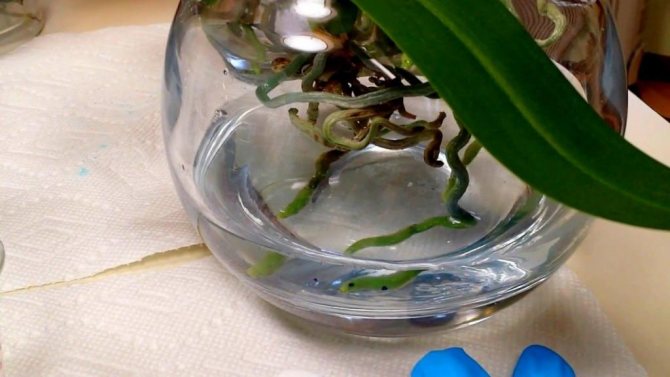

As soon as the length of the new roots reaches three to four centimeters, the plant can be transplanted into the substrate. But you need to take not the container in which the plant was previously contained, but a small pot. Peat is suitable. Such a container is convenient because when the roots are restored, a transplant is not required, which injures the orchid. Phalaenopsis can simply be moved entirely to a new container with a substrate.
Watering after transplanting a practically healthy plant is necessary as usual. For two to four weeks, the plant must be fixed on a support. Phalaenopsis will begin to recover after a while. A root baby may appear, which is undesirable to remove, because this will weaken the plant.
Phalaenopsis orchid fusarium rot (fusarium)
Understand that the plant is sick fusarium rot, it is possible on yellowing leaves and young shoots, the appearance of spots on them. The leaf blades soften and curl, a light bloom may be noticed on them, representing the spores of the fungus. Threatened by fusarium rot, phalaenopsis orchids and other species kept in sparsely ventilated rooms with high humidity.
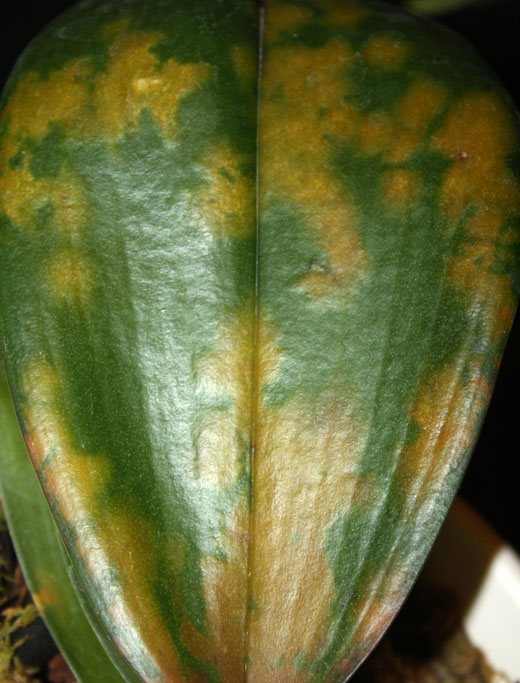

Signs of fusarium rot on the leaves of a room orchid.
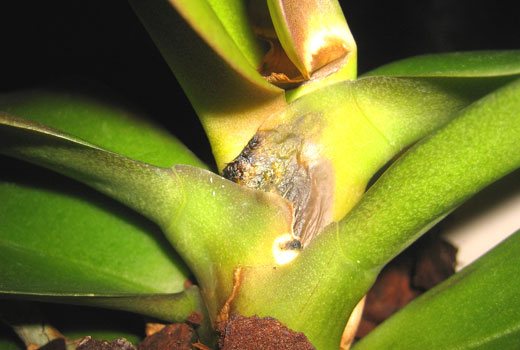

The plant is severely affected by fusarium, all tissues are affected.
What to do to keep the foliage from disappearing?
If the florist notices that the leaves of the plant are beginning to rot, you should immediately take measures to save it:
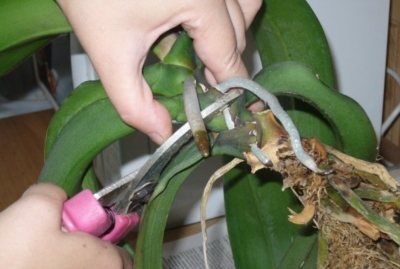

- Place the flower in another room to isolate it from healthy plants.
- Trim off any damaged leaves. In this case, the instruments must be calcined or treated with an antiseptic. The resulting cut on the trunk is also disinfected using activated charcoal or an alcohol-free antiseptic.
- After removing the damaged leaf part, a fungicide is applied.
- It is imperative to treat the window frame and the window sill on which the sick orchid stood.
- If possible, the flower is transplanted into another pot, and the old one is soaked for four hours in soapy water.
- After processing, it is recommended not to moisten the soil for a week.
- Be sure to look at the wounds that have formed at the time insects appear in them and treat them every day with charcoal, cinnamon or antiseptic, but only without alcohol.
Attention! All leaves should be trimmed to a green cloth to avoid getting rot in the heart of the flower. If the rot is inside the core, it should be removed, the plant can live without it, it will just take a little longer to recover.
What if the leaves turn yellow?
There are various reasons for yellowing. The main ones are:
- violation of the irrigation regime;
- thermal disturbances;
- sunburn;
- wrong fertilizers;
- disease.
Leaves can turn yellow naturally as they age and fall off soon. As a rule, the color change starts from the bottom of the orchid. Cutting them is not worth it, this will injure the flower.
Important! The plant needs to be inspected regularly, rot spreads very quickly.
The most common cause is improper watering. If the orchid is irregularly watered, its leaves may turn slightly yellow. In case of serious violations, completely change the color. But this plant does not tolerate an excessive amount of moisture.
Maybe the orchid has been exposed to the sun's rays for too long, or not at all. Sharp temperature changes also affect the color. When the colored spots grow, it speaks of the disease.
Once the cause is found out, you need to eliminate it. In case of violation of the care regimen - return to normal, in case of diseases - remove the affected areas, treat the plant with fungicides, improve care.
How to transplant an affected orchid?
It is necessary to carefully examine the flower and determine in what condition the neck or base is, and then carefully remove the plant from the flowerpot. Remove the substrate from the roots. The peduncle is cut off. Remove all rotten or dry unwanted parts until healthy tissue. The resulting wounds must be sprinkled with a bactericidal agent, as well as the necessary drug to combat decay and disease.
The orchid is transplanted into a new pot with a clean substrate. It is impossible to water immediately, it takes time. The reanimated plant must be constantly monitored.
The flower must be removed from the sun's rays and monitored in the greenhouse. No watering required.
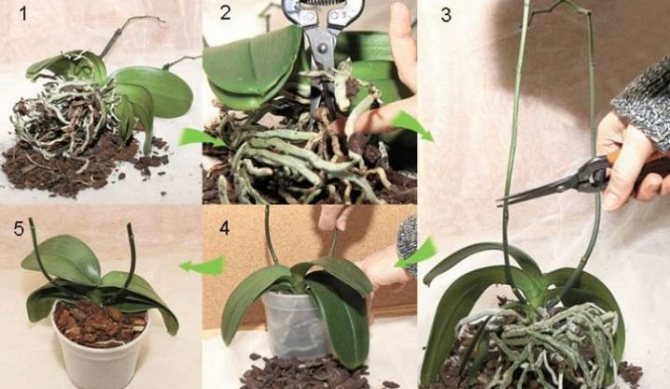

Flower resuscitation
There is a way to save an orchid from a lost growth point. The cleaned plant must be processed and lowered into a vase with water at room temperature, while the upper part should not come into contact with moisture. They are placed in a well-lit place. Unlike processing the core, you do not need to overdo it with cutting off the roots affected by rot, since they may not recover, and new leaves will not grow with them.
The lower part must be tried to be restored. The soft damaged velamen is removed, leaving springy cores called strands. These are the real roots of phalaenopsis, if they are still elastic, then you need to leave their length. If the plant starts to be left without the top, no need to wait. The orchid is taken out of the flowerpot, the lower part is examined.A sick flower is placed in a greenhouse, placing a piece of polystyrene and wet moss under it. After the listed procedures, a new root system will appear and leaves will grow again.
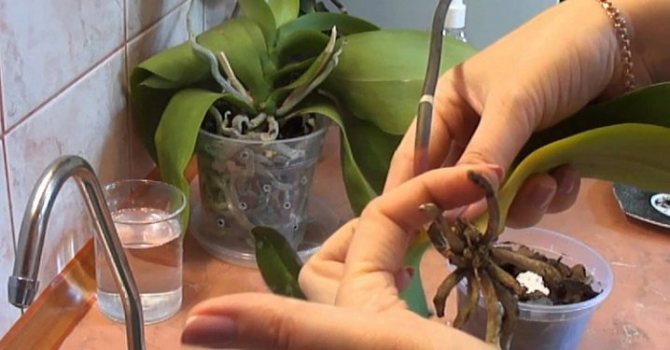

How to cure plaque on leaves?
Plaque can occur due to:
- gray rot;
- mosses and algae;
- whitefly infection;
- rust;
- mealy worm.
Treatment varies depending on the cause. If it is a fungal infection (gray rot, rust, etc.), use fungicides. And if a white bloom appears, then the matter is in pests, and only an insecticide will help.
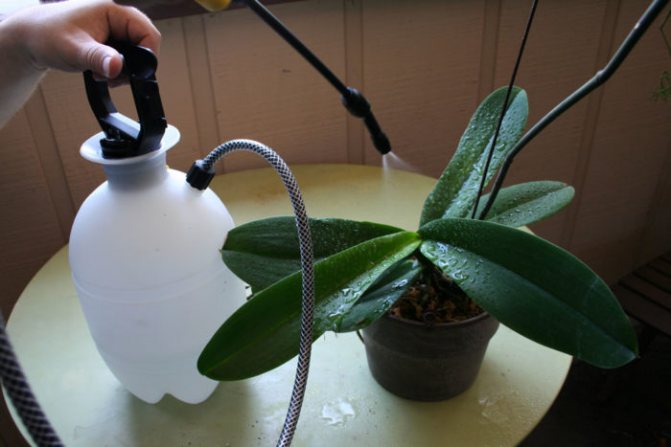

Plant life cycle
The orchid has 3 periods - a period of rest and active growth, as well as a flowering time, which lasts about 2 months. Until this moment, the growth of peduncles and buds occurs. After the last flower falls, the plant does not immediately retire, but after 15-20 days. Yellowing and dropping of the lower row of foliage is considered a natural process.
Orchids need to discard old foliage when enough new foliage grows, because it is not able to "feed" all the leaves.
The consequences of plant blackening
When visually examining the phaleopsis, dark spots, blotches, black tips or roots are noticeable - this is a signal for action. The plant needs emergency help. If the treatment does not arrive in time at the right time, then the orchid is on the verge of death (we talked about whether it is possible to save an orchid without roots and leaves and how to do this, we talked about in our material). It is possible that in the later stages, this lesion can cause the process of orchid decay: dots will appear on the flowers and the stem, gradually the whole flower will turn black, and in such a case, it is already pointless to do something.
Means that can save the plant if the leaves are rotten


Chemical.
Fitoverm (or analogs) is harmless to humans, but effective against pests. The solution that remained after the treatment procedure should in no case be poured into a reservoir or sewer. The container in which Fitoverm was divorced is burned. Another potent remedy is Actellic. It is used in the most difficult situations.

Natural.
One of the most common natural remedies is soap solution. It helps to overcome various infections, fungi, insects. Very easy to prepare. They can wipe the roots, foliage, completely fill the soil. In order to prevent, the next 5-6 days it is necessary to spray the flower with soapy water.
Causes and diseases
At home, when the leaves of an orchid turn black, the florist himself makes the diagnosis. It is not difficult to do this by comparing the symptoms. Additionally, there may be a delay in flower growth, greenery shedding, tissue necrosis. The spots can be of different sizes, types: dots, veins, depressions, thin sinewy, or thick fleshy, depending on the type of orchid, dry and wet, first turn yellow, or immediately show black.
On phalaenopsis, heat burn and solar burn are similar. It arises from jets of hot air of a fan heater, batteries. They look like a black spot framed by a yellow stripe. It is impossible to cure the plant, the leaf itself, when it grows old naturally, will fall off. Also, orchid leaves turn white, turn brown, blacken with spots from sunburn, forming depressions. Remember that even the most heat-loving exotic plants are afraid of direct sunlight, so they need to be shaded from May to October.
A disease caused by pathogenic bacteria, manifested on greenery by dark spots in Oncidiums, Cymbidiums. Similar to burns, but tend to increase. Fusarium wilting is characterized by depressed dark spots, a kind of bubbling of tissues, their subsequent crumbling, when only a black mesh remains, as a result, the fall of greenery.
Fungal infections
In the wild, infections are transmitted from trees, pathogens may get from plants illegally exported from Asia.Often found on Dendrobiums, they can be dangerous to humans. At first, the spots of the fungus Exserohilum rostratum are dark with a yellow rim, then the center dries out, whitens or perforates.
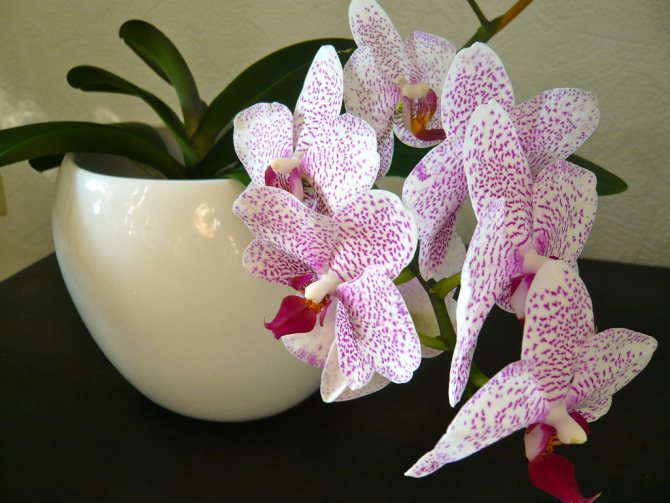

With septoria, Oncidium, Lelia, Cattleya, Cymbidium most often suffer from the pathogen Septoria selenophomoides. The spots are initially wet, then darken, acquiring a brown, black tint, are pressed in, a yellow edging appears. Outwardly similar to bacterial spotting. It is also treated with fungicides, it is necessary to remove diseased shoots with disinfection of the sections.
Oddly enough, but orchids can also be sick with viral diseases. If a similar diagnosis was found in one plant, it must be urgently removed from others and destroyed. There is no effective method for treating a plant from viruses.
The most unpleasant thing is that the virus does not appear in the plant for a long time. It can be evidenced by the changed shape and color of the plant. Remember: if you have several flowerpots and common watering in one container, all plants are infected.
The virus can be brought in by processing the orchid with tools. As soon as favorable conditions for its reproduction appear, it is immediately activated. Such conditions are a sharp decrease or increase in temperature, humidity, changes in the habitat, which lead the orchid to stress.
If you suspect that a plant is infected with a virus, first it must be isolated and treated with any antibiotic, and then with a fungicide.
Orchids are amazing flowers that can decorate any room. But they are quite demanding in care, deviation from which leads to various diseases. It is necessary to constantly carry out various preventive measures, to stimulate the growth and flowering of the plant.
What is the cause of the barrel damage?
- Mechanical damage.
Rot can form as a result of falling or injury to a part of the flower. If you do not provide assistance in time, that is, treat the damaged area with an antiseptic, then the result will be rotting of the stem. Frostbite.
Newbie flower growers carelessly irrigate. They make a warm shower for the orchid, but they forget about the water that accumulates in the sinuses. There is nothing dangerous in this during the summer. Hot weather will quickly evaporate the water.
Signs of illness
The following symptoms may indicate the disease:
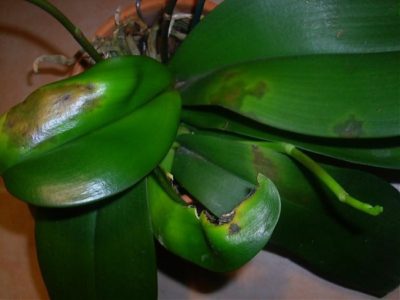

The leaves became less elastic, acquired softness.- Darkening and drying of aerial roots.
- The plant became unstable, wobbly.
- There is a plaque of spores on the inner walls of the pot.
All these are early signs of orchid putrefactive diseases. With the initial resuscitation actions, the flower can be brought back to life. But first it is worth finding out why the orchid began to die.
How to visually determine that a flower is sick and needs to be reanimated?
It is quite easy to understand that putrefactive processes have begun to develop on the flower. The orchid will show characteristic symptoms for this:
- foliage begins to actively turn yellow and darken at the base;
- the leaves become lethargic and unattractive;
- the brightness of the deciduous part decreases, it becomes paler;
- new leaves practically do not appear, and flowers may begin to fall off;
- gradually the stem becomes less elastic and cannot keep the plant in the desired shape.
Important! Even if the rot has led to the death of the flowers, the orchid can still be reanimated. But after decay of the root system, it is almost impossible to do this.
Treatment methods
If any black spots are found, they need to be diagnosed and treated. The sooner treatment is started, the more chances for the plant to recover.
Isolation and compliance with the rules of plant care
First of all, the damaged the plant must be removed to the quarantine zone, since his disease can spread to the specimens standing nearby.
The sooner the flower is quarantined, the more likely it is other flowers will not get infestation.
After that, the peduncle is removed, even if it is a long-awaited bloom. The orchid is not up to it now, it needs strength to recover after medical treatments.
If the cause of the disease is harmful insects, they are worth identifying and processing the flower appropriate chemical.
If this is a fungal disease, then it is treated with preparations containing copper... At the same time, watering is reduced, and the temperature in the room must be steadily warm.
IMPORTANT! You can save the flower if the disease is detected at the initial stage.
Determining the cause of the disease
To diagnose diseases, you need to know what they look like.
Pruning peduncles
When a disease is detected you need to remove the peduncleeven if it is important for the grower. The plant may fail to maintain flowering and die. This must be done according to all the rules.
The flower branch is cut with a prunerwell processed in alcohol. The pruner makes sharp cuts in which the wounds heal quickly. Sometimes the orchid has a hollow peduncle, and so that there is no rotting, the cut is treated with garden pitch. It can be purchased at garden centers.
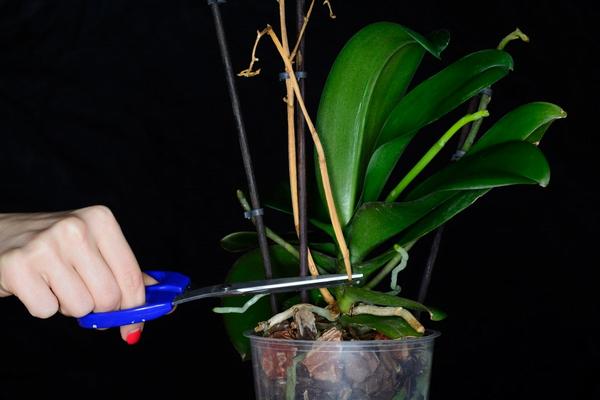

Pruning orchid stalks should be done according to the rules.
Treatment with drugs against pests
Each detected pest is suitable for a specific drug that can neutralize it. Actellic is a drug that helps against almost all harmful insectsthat can be found on the orchid.
The drug is very toxic and is used only on the street.so as not to harm yourself and the animals. For some pests, one treatment with the drug is enough, others will need to be treated at least 3 times. You can get rid of the scabbard only by removing it with your hands, and after that you can sprinkle it with the appropriate preparation.
IMPORTANT! The earlier the pest is noticed, the more chances it is to remove it from the plant.


Actellik preparation for pest control.
Trimming the sheet plate if the damage is significant
If the entire sheet is affected or the damage takes up a significant part, it is better not to cut the sheet, but remove it completely... To do this, make a small incision from the outer edge of the sheet and stretch the 2 halves in different directions.
This method of removal allows you to remove the blackened leaf completely without residual cover. It is still better to treat the junction of the sheet with the trunk with charcoal.... If the leaf is blackened from the edge, then it is cut off with sharp scissors and the cut edge is treated with an antiseptic.
What to do if fungal diseases are found?
So that the fungal disease does not multiply throughout the bush, it is necessary to stop watering, reduce humidity... Then a fungicide containing copper oxide in its composition is purchased and the flower is treated as written in the instructions on the package.
You can also do this. for prevention, because if the spores of fungi fall into the middle of the plant, they can not be removed at all, and the plant will be constantly in the stage of infection, which will lead to its death
Preventive measures
To protect the orchid from the appearance of traces of rot, it is enough to follow a number of simple recommendations:
- keep the flower in a well-lit room with normal humidity;
- if possible, maintain the temperature in the room at 18-24 degrees;
- moisten the soil only after it is completely dry;
- do not allow water to accumulate in the pan;
- in highly humidified air, do not carry out additional spraying of the flower;
- half an hour after irrigation with a soft sponge, remove excess moisture from the leaves;
- do not use complex fertilizers with a high nitrogen content;
- before planting, pierce the soil or spill it with boiling water to kill all pathogens;
- for fertilization, special compositions are used, where there is no more than 14% nitrogen;
- the soil should be completely changed every three years.
Important! To protect the orchid from decay, it must be sprayed with a solution of copper sulfate once every four weeks.
It is difficult to deal with the processes of decay in an orchid, therefore it is easier to carry out preventive measures to prevent diseases and monitor watering and the place where the flower is kept. With proper care, the plant constantly blooms beautifully and pleases with bright foliage.
If you find an error, please select a piece of text and press Ctrl + Enter.
Step-by-step instructions for decay
Necks
- The first step is to prepare the blade and disinfect it.
- Further, the entire damaged part of the neck is cut off up to the living tissue.
- Slices are carefully cleaned with a blade.
- Then the soil and the orchid are treated with a 0.2% Fundazol solution. The product is poured directly onto the wound.
- This is done 3-4 times with an interval of 2 weeks.
- The pot is put in the previous place, we are waiting for the appearance of the side baby.
To cope with a decayed orchid neck, watch the video:
At the "point of growth
- Remove all infected areas so that not a single dark spot remains.
- Disinfect the sections.
- If the disease is infectious or as a precautionary measure, topical fungicides are used.
- The orchid will need constant inspection, because rot may return.
If rot has hit a growth point, watch this video:
Cores
- Rotten places are removed.
- If necessary, the core is removed completely.
- After each cut, the tools are processed.
- The wounds are cauterized with cinnamon, iodine, activated carbon.
- Closely observe the condition of the plant.
How to treat stickiness?
Sweet sticky sap on plants can be both normal and a sign of disease. Main reasons:
- This is the norm. Sticky droplets appear on leaves and stems to attract insects that pollinate the orchid and protect it from pests. In this case, the fight against them can only do harm.
- The current care regimen injures the plant. If conditions are not improved, various diseases can develop, including viral ones. In this case, a change in the regime and good conditions of detention will relieve the stickiness.
- Pests. It is necessary to inspect the orchid for the presence of insects, if detected, treat it with insecticides.

